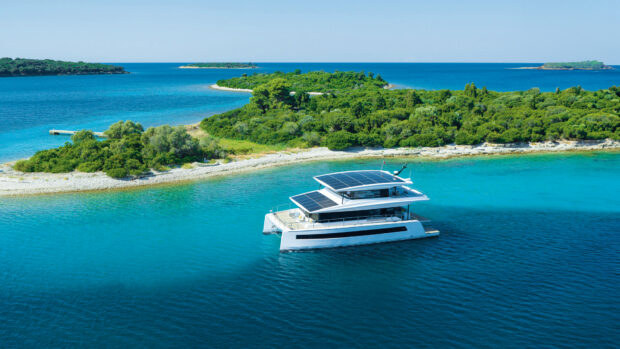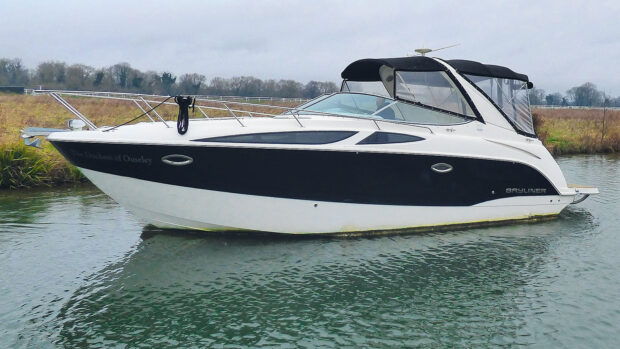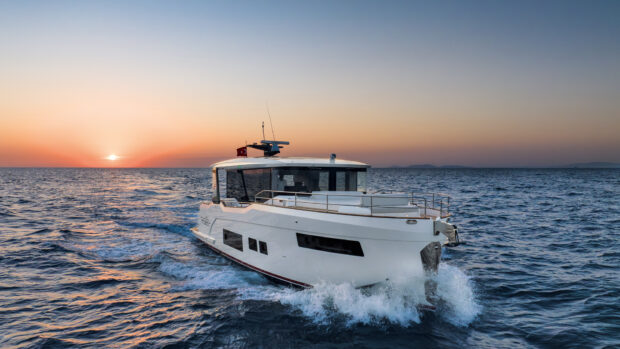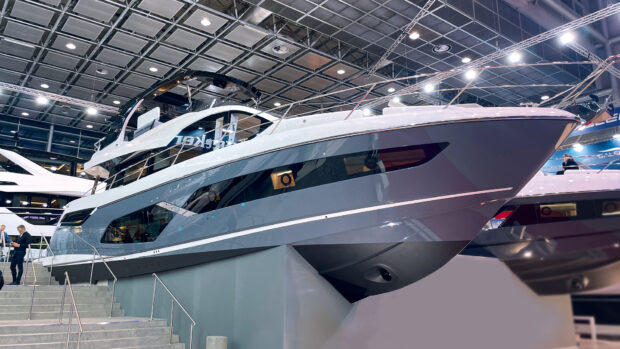The Fairline Phantom 42 is just one of a, frankly, staggering array of variants, but how does this particular model hold up 25 years after launch?
Fairline first introduced its Phantom range half a century ago with the Fairline Phantom 32. It would be the first in a long line of popular family cruisers which endures to this day. But while the Phantom name has become synonymous with flybridges, it wasn’t always that way.
One of the earliest 32s was a hard-topped cabin cruiser, designed specifically for use on the inland waterways and over the years, the growth of the Phantom range has seen plenty of variety too. It has progressed through a staggering number of variants, including the 38, 40, 41, 42, 43, 46, 48 and 50 – all the way up to today’s flagship 65-footer.
Interspersed with Phantoms since 1991 has been another popular Fairline flybridge product, the Squadron. While there has been some overlap in terms of length (the current Squadron range, for example, runs from 50 to 68ft), its higher levels of spec, styling and sophistication continues to differentiate the Squadron as the more upmarket of the two.
Although the multitude of ‘year versus length’ permutations that exist between Squadrons and Phantoms makes for some interesting comparisons on the used market today, that’s not something that affects the subject of this review. That’s because every one of the 116 Phantom 42s that Fairline built were constructed between 1997 and 1999, more than a decade before the Squadron 42 was even introduced.

The compact flybridge positions the helm at the heart of the seating zone
The Phantom 42 was the final iteration of the first generation of Phantom 40s (in build from 1994 to 1999 and not to be confused with the second 40ft incarnation which was launched in 2002). As such, it shares many of its features with the Phantom 40 – and when MBY tested one back in 1995 on a delivery run to Jersey, our writer shared his concern regarding restricted visibility from the lower helm.
However, he partially allayed those fears by reporting that once on the plane, the lift of the bows gave a clear view of the horizon. He still had to duck to look out of the side windows but of course visibility restrictions are only likely to be an issue in inclement weather, when the vessel can’t be helmed from the flybridge.

The compact flybridge positions the helm at the heart of the seating zone
The owner’s perspective
On the books of Swanwick-based Solent Motor Yachts at an asking price of £149,000 VAT paid, our review boat’s owner, Richard Frost, explained the chief attraction of the vessel to him – and it has to be said, it’s a view we weren’t expecting: “I wanted a flybridge because I got fed up with taking the covers off and putting them back on again,” he says.
“I’ve had a number of boats before and they’ve all had canvas lids and I got totally and utterly fed up with all the faffing around – it was just painful. Now, from April onwards I simply take all the covers off the back. I’ve reupholstered all the seats in the aft cockpit with a waterproof fabric, so it’s very straightforward.
Article continues below…

Bavaria Sport 400 Coupé used boat review

Best boats around £150k: Our pick of the secondhand market
“I just get on board, open the sliding door and off I go. I do tend to leave the covers on the flybridge seating and over the helm station, but that’s easy. I can have them on or off in a matter of minutes.”
With regards to Richard’s comment on getting aboard, it’s worth noting that although the side decks sit around 5ft above the waterline, the extended bathing platform of the Phantom 42 makes it considerably easier to access from an alongside berth than the original Phantom 40 – the owner of our original test boat had fitted brackets to hold a boarding ladder for this very reason.

While visibility isn’t the best, the Phantom 42 is a comfy and capable sea boat
Another more mainstream factor that particularly appealed to Richard about the 42 was simply the look and build quality of the boat: “I just love that sort of classical design,” he says. “And I think it’s fair to say that they didn’t scrimp on the GRP in those days – it’s a very solid boat.”
He’s exactly right. With a dry weight in excess of 10 tonnes, the Phantom 42 is unquestionably a hefty chunk of marine engineering. It radiates an impression of solidity which is emphasised by the smooth, curved lines that run from bow to stern. That reassuring sense of weight continues below decks, where the levels of insulation provided by the hull are such that there’s little chance of anything but the loudest extraneous noise creeping in.
In terms of propulsion, the Phantom 42 was offered with a choice of Volvo Penta TAMD marine diesels: the 318hp 63L or the 370hp 63P version, with top speeds (quoted by the manufacturer) of 28-31 knots and 31-33 knots respectively.
The figures we quote in the data file at the end of this report are taken from our 1994 Phantom 40, which had a pair of 355hp Caterpillar 3116 TAs and should therefore represent a pretty fair middleground between the two Phantom 42 options. Being a shaft-drive boat, the engines are located amidships and accessed through two large hatches in the saloon floor. Achieving this involves sliding the saloon table out of the way and manually hauling up the well-insulated but heavy hatches.

Though not quite as premium as the Squadron line, there are plenty of neat little touches
As for the seakeeping, that’s everything you would expect of an Olesinski hull. Owner Richard confirmed this for himself when he took his boat out to watch the start of last year’s Fastnet race in horrendous conditions.
“From memory, it was about F7,” he says. “We headed for Yarmouth, got just past it and were thinking, ‘Oh no, this is getting really rough now!’. So we turned around at that point, but she took it really well. The biggest problem was that the waves kept coming over the bow. I couldn’t see much through the windscreen but she handled the chop fine.”
Targeted upgrades
The Phantom 42 is rated to carry 12 passengers and with four spacious social areas _ the aft cockpit, the saloon, the flybridge and the foredeck sunpads – it would have no problem accommodating them all. But it’s far more likely to be used as a family cruiser and to that end, its lower deck is arranged around two cabins. The owner’s cabin has an island bed and an ensuite bathroom, while the second cabin features twin beds and a washroom that doubles as a day heads, thanks to Jack and Jill doors.

There’s plenty more heavyweight high-gloss cabinetry aft of the port seating
Should extra beds be required, the L-shaped settee to the starboard side of the saloon also has a convertible pull-out double. However, as Richard points out, that original set-up was not to his liking so he changed it. “It was like a sofa bed; a pull-out springy thing which was just so uncomfortable,” he says. “So I got rid of that and replaced it with a slatted base. Now you pull out a drawer underneath it and there’s a cushion inside, which makes up a double berth.”
That’s not the only upgrade Richard has undertaken and that’s something potential buyers of a vessel of this vintage would do well to bear in mind: “I had to redo all the nav gear. The radar, the Glomax TV antenna,” he says. “I also fitted a new over-carpet in the saloon and refurbished the galley floor. The guy before me had put a laminate down there and it was just horrendous. We also re-upholstered the external seats, top and bottom, with Silvertex, before replacing the life raft and renewing the automatic fire extinguishers.”

The owner gets an elevated island bed and a private ensuite bathroom
One final point about the Phantom 42, and this is very much a positive in our view, is that the vessel dates from an era when boatbuilders (probably to the detriment of their bank balances) appeared to put finish above finance. As a result, you can expect to find beautifully crafted cabinetry with deep gloss varnish, plush seating and high-quality fixtures and fittings throughout.
In truth, the saloon woodwork on our review boat did show a few signs of fading due to many years of exposure to sunlight, but this remains a very comfortable boat with a classically luxurious feel. In short, if you’re working to a budget of £100-150k and you’re not alarmed by the prospect of owning a 25-year-old vessel, a Phantom 42 could be well worth considering. After all, in return for a few age-related niggles, you’re buying yourself an awful lot of boat for the money.

The ensuite twin cabin makes this a very practical boat for family cruising
Fairline Phantom 42 specifications
MODEL: Phantom 42
DESIGNER: Bernard Olesinski / Fairline
HULL TYPE: Deep-vee planing
RCD: B12
LOA: 42ft 9in (13.02m)
BEAM: 13ft 2in (4.01m)
DRAFT: 3ft 3in (1m)
DISPLACEMENT (DRY): 10,670 kg
FUEL CAPACITY: 2 x 568l
WATER CAPACITY: 550l
TOP SPEED: 30.6 knots (Phantom 40 with twin Cat 3116 TA 355hp engines)
FUEL CONSUMPTION: 2.8l/nm @ 21 knots
RANGE: 324nm at 21 knots with 20% reserve
Fairline Phantom 42 costs & options
FUEL: Annual estimated fuel burn 1,700 litres (based on 25 hours at 21 knots and 25 hours at 6 knots)
BERTHING: £9,244.20 (based on £710/m for a Hamble River marina downstream of Bursledon bridge)
 If you enjoyed this….
If you enjoyed this….
Motor Boat & Yachting is the world’s leading magazine for Motoryacht enthusiasts. Every month we have inspirational adventures and practical features to help you realise your sailing dreams, as well as tests and news of all the latest motorboats.
Plus you’ll get our quarterly Custom Yachting supplement where we share the last on offer in the superyacht world and at the luxury end of the market.
Build your knowledge with a subscription delivered to your door. See our latest offers and save at least 30% off the cover price.



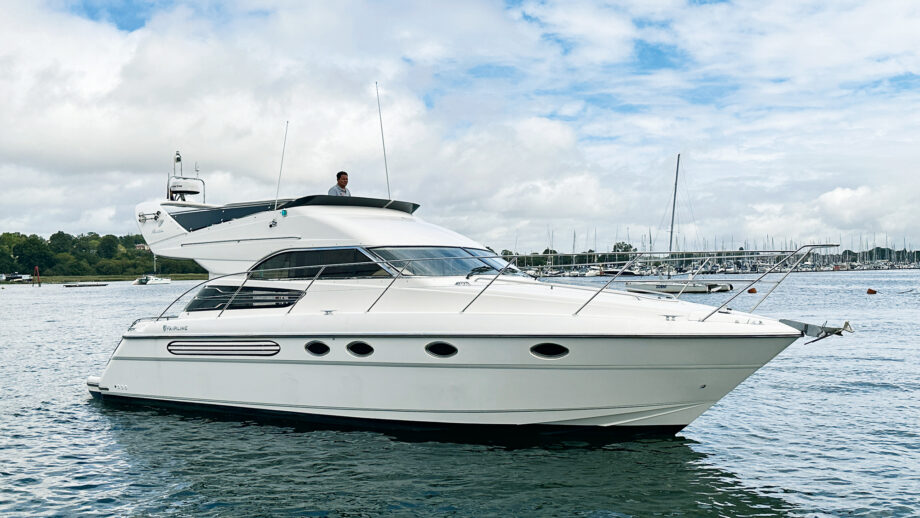
 If you enjoyed this….
If you enjoyed this….